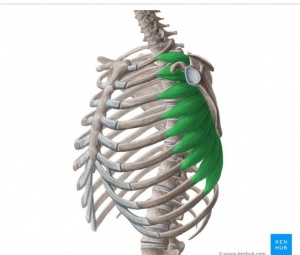Serratus Anterior: Difference between revisions
No edit summary |
No edit summary |
||
| Line 1: | Line 1: | ||
'''Original Editor '''- [[User:Esraa Mohamed Abdullzaher|Esraa Mohamed Abdullzaher]] | '''Original Editor '''- [[User:Esraa Mohamed Abdullzaher|Esraa Mohamed Abdullzaher]] | ||
| Line 40: | Line 40: | ||
== Palpation == | == Palpation == | ||
== Treatment == | == Treatment == | ||
=== Video === | |||
{{#ev:youtube|kTxqYkDdle4}} | |||
== Resources == | == Resources == | ||
== References == | == References == | ||
Revision as of 10:56, 27 June 2018
Original Editor - Esraa Mohamed Abdullzaher
Top Contributors - Lucinda hampton, Kholoud Abd Elghany, Kim Jackson, Joao Costa, Lilian Ashraf, Esraa Mohamed Abdullzaher and Oyemi Sillo
Description[edit | edit source]
The serratus anterior muscle is a fan-shaped muscle at the lateral waii of the thorax.
Its main part lies deep under the scapula and the pectoral muscles.
It is easy to palpate between the pectoralis major and latissimus dorsi muscles.
Origin[edit | edit source]
It originates on the top surface of the eight or nine upper ribs. [1]
Insertion[edit | edit source]
It inserts exactly at the front border of the scapula, or shoulder blade.[1]
The muscle is divided into three parts :
Upper / Superior : 1st to 2nd rib → superior angle of scapula.
Middle / Intermedius : 2nd to 3rd rib → medial border of scapula.
Lower / Inferior : 4th to 9th rib → medial border and inferior angle of scapula.
It is the most powerful and prominent part.
Nerve[edit | edit source]
The long thoracic nerve ( C5_7) supplies the serratus anterior muscle.
Function[edit | edit source]
The function of the serratus anterior muscle is to allow the forward rotation of the arm and to pull the scapula forward and around the rib cage. The scapula is able to move laterally due to the serratus anterior muscle, which is vital for the elevation of the arm. The serratus anterior muscle also allows the upward rotation of the arm, which allows a person to lift items over their head.[1]







